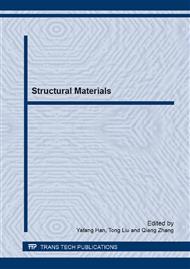p.34
p.41
p.45
p.52
p.58
p.64
p.68
p.74
p.78
Effect of Ce Addition on Microstructure and Mechanical Properties of ZM21 Magnesium Alloys
Abstract:
In this paper, the effects of Ce addition on the microstructure and mechanical properties of the cast and extruded ZM21 magnesium alloy were investigated by OM, XRD, SEM and tensile test at room temperature. It was found that with increase of Ce content, the Mg-Ce and Mg-Zn phases which gather in dendritic gap as second phases increase gradually, and form a network structure finally, which becomes thicker due to serious segregation. Meanwhile, Most of Ce in the extruded ZM21 magnesium alloy is in the forms of second phases, and is broken and dispersed in the matrix alloy during the plastic deformation. With the increase of Ce content, the quantity of the second phase increases, and both the tensile strength and the elongation of ZM21 alloys decrease firstly and then increase. When the content of Ce is 0.57%, the elongation barely reaches the level of ZM21 magnesium alloy. After extrusion, both the tensile and yield strength have been greatly improved.
Info:
Periodical:
Pages:
58-63
Citation:
Online since:
April 2014
Authors:
Keywords:
Price:
Сopyright:
© 2014 Trans Tech Publications Ltd. All Rights Reserved
Share:
Citation:


